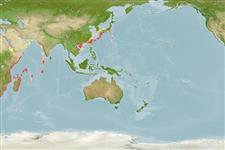>
Pleuronectiformes (Flatfishes) >
Soleidae (Soles)
Etymology: Aseraggodes: Greek, aggos, -eos, -ous = vessel, uterus, carapace of a crab + Greek, aseros, -a, -on = to remove the appetite (Ref. 45335).
Environment: milieu / climate zone / depth range / distribution range
Ecologia
marinhas demersal; intervalo de profundidade 6 - 10 m (Ref. 56490). Temperate
Indo-West Pacific: Sodwana Bay (South Africa), Porto Amelia (Mozambique) and Japan.
Tamanho / Peso / Idade
Maturity: Lm ? range ? - ? cm
Max length : 8.0 cm TL macho/indeterminado; (Ref. 3200)
Espinhos dorsais (total): 0; Raios dorsais (total): 64-67; Espinhos anais 0; Raios anais : 42 - 44; Vértebras: 33 - 34. Diagnosis: Dorsal rays 64-67; anal rays 42-44; dorsal and anal rays are not branched. Caudal rays 18, the middle 14 branched. Lateral-line scales of ocular side 64-67; the line extending forward nearly to upper eye, with a ventral branch on head following the edge of the preopercle. Vertebrae 10 + 23-24. Dorsal pterygiophores anterior to fourth neural spine 14-15. Body depth 2.4-2.5 in SL; head length 3.55-3.65 in SL; snout long, 2.6-2.95 in head length; interorbital space narrow, 13.7-20.8 in head length. Caudal peduncle very short, 19.5-23.2 in HL. Tubular anterior nostril anterior to upper edge of lower eye, just reaching cutaneous edge of lower orbit when depressed posteriorly. Two rows of scales in interorbital space, none extending onto medial edges of eyes. Anterior edge of snout of largest specimen (23 mm SL) with a series of 12 conspicuous lappet-like cirri. Ventral margin of head with 20 similar cirri, the longest on chin about equal to pupil diameter; no cirri on opercular edge of either side of gill opening. Jaws of blind side surrounded by a zone of small papillae. Dorsal and anal rays long, the longest dorsal ray 2.5-3.0 in HL. No sheath of scales over base of dorsal and anal fins, at most one row of scales over basal part of rays. Rounded caudal fin and moderately long, 3.2-3.45 in SL. Pelvic fins long, reaching base of third or fourth anal ray, 1.65-1.9 in HL. Color of ocular side when fresh light gray with large irregular dark-edged white spots on head and body, scattered small whitish spots, fewer small black spots, a black spot the size of eye on lateral line in middle of body and a double black spot on lateral line in middle of posterior half of body (Ref. 56490).
Inhabits sand bottoms including reef flats and tide pools in 0-10 m (Ref. 90102).
Ciclo de vida ou comportamento de acasalamento
Maturidade | Reprodução | Desova | Ovos | Fecundidade | Larvas
Heemstra, P.C. and O. Gon, 1986. Soleidae. p. 868-874. In M.M. Smith and P.C. Heemstra (eds.) Smiths' sea fishes. Springer-Verlag, Berlin. (Ref. 3200)
Status na Lista Vermelha da UICN (Ref. 130435)
Ameaça para os humanos
Harmless
Uso pelos humanos
Mais informação
Nomes comunsSinônimosMetabolismoPredadoresEcotoxicologiaReproduçãoMaturidadeDesovaAgregação de desovaFecundidadeOvosDesenvolvimento dos ovos
ReferênciasAquaculturaPerfil para aquaculturaEstirpesGenéticaElectrophoresesHereditariedadeDoençasProcessamentoNutrientsConversão de massa
Ferramentas
Relatórios especiais
Baixar XML
Fontes da internet
Estimates based on models
Preferred temperature (Ref.
123201): 23.5 - 28.9, mean 27 °C (based on 509 cells).
Índice de diversidade filogenética (Ref.
82804): PD
50 = 0.5000 [Uniqueness, from 0.5 = low to 2.0 = high].
Bayesian length-weight: a=0.00977 (0.00473 - 0.02021), b=3.07 (2.90 - 3.24), in cm total length, based on LWR estimates for this (Sub)family-body shape (Ref.
93245).
Nível Trófico (Ref.
69278): 3.4 ±0.5 se; based on size and trophs of closest relatives
Resiliência (Ref.
120179): Elevada, tempo mínimo de duplicação da população menor que 15 meses (Preliminary K or Fecundity.).
Fishing Vulnerability (Ref.
59153): Low vulnerability (10 of 100).
